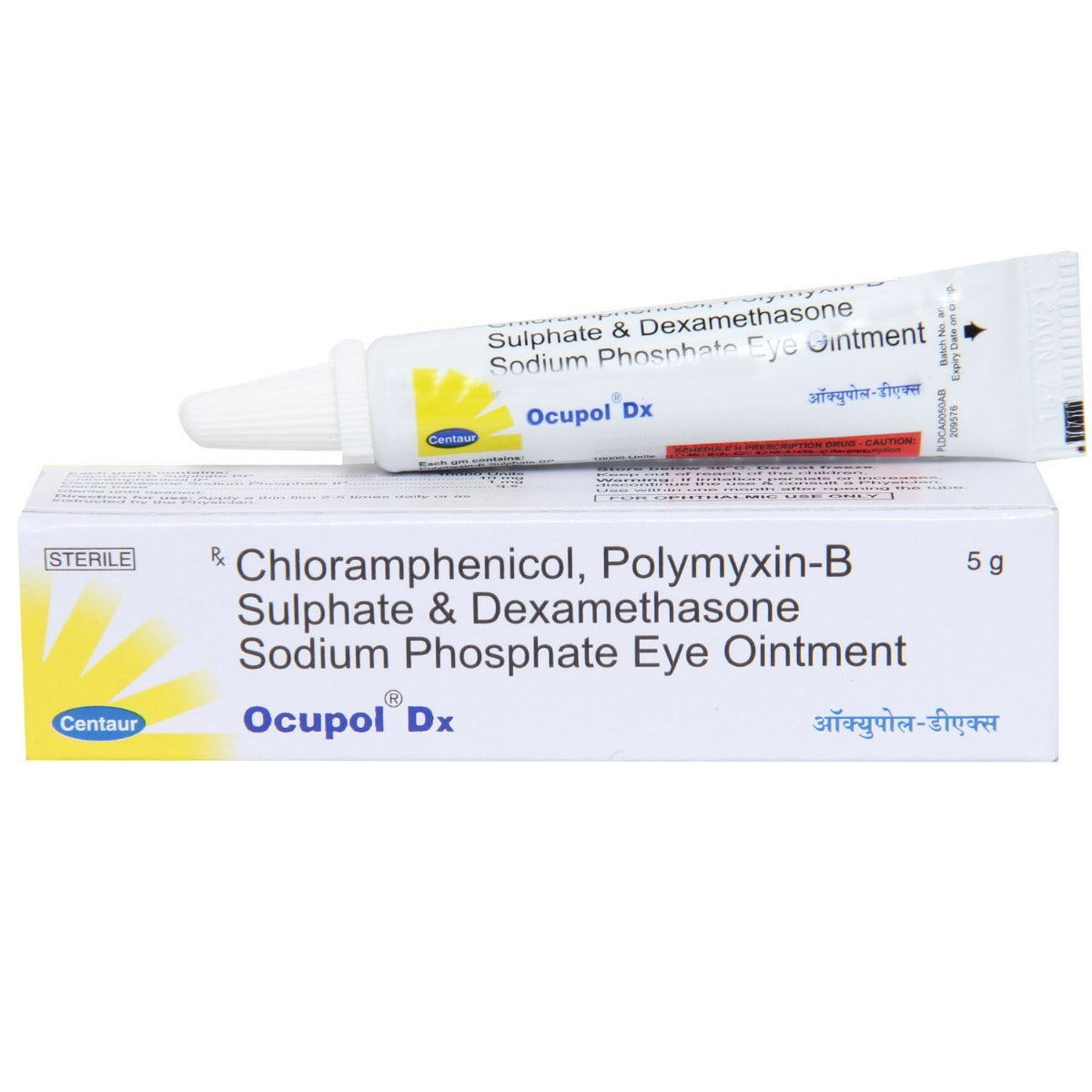Ocupol DX Eye Ointment 5 gm



MRP ₹136
(Inclusive of all Taxes)
₹20.4 Cashback (15%)
know your delivery time
Provide Delivery Location
Manufacturer/Marketer :
Consume Type :
Expires on or after :
Return Policy :

Secure Payment

Trusted by 8 Crore Indians

Genuine Products
Therapeutic Class
Country of origin
Manufacturer/Marketer address
Author Details
We provide you with authentic, trustworthy and relevant information
Disclaimer
Alcohol
Safe if prescribed
It is not known whether alcohol affects Ocupol DX Eye Ointment 5 gm. Please consult your doctor.
Pregnancy
Consult your doctor
Please consult your doctor before using Ocupol DX Eye Ointment 5 gm if you have any concerns regarding this; your doctor will prescribe only if the benefits outweigh the risks.
Breast Feeding
Consult your doctor
Please consult your doctor before using Ocupol DX Eye Ointment 5 gm if you are breastfeeding. Your doctor will decide if breastfeeding mothers can use Ocupol DX Eye Ointment 5 gm or not.
Driving
Safe if prescribed
Ocupol DX Eye Ointment 5 gm may cause blurred vision. So, avoid driving vehicles or operating machinery unless your vision is clear.
Liver
Consult your doctor
Ocupol DX Eye Ointment 5 gm should be used with caution in patients with liver impairment. Please consult your doctor if you have any concerns.
Kidney
Consult your doctor
Ocupol DX Eye Ointment 5 gm should be used with caution in patients with kidney impairment. Please consult your doctor if you have any concerns.
Children
Safe if prescribed
The safety and effectiveness of Ocupol DX Eye Ointment 5 gm in children have not been established. Please consult your doctor if you have any concerns.
Product Substitutes
Reference
- https://www.centaurpharma.com/downloads/2021/ophthalmology/anti-infectives/Ocupol%20DX.pdf
- https://patient.info/medicine/dexamethasone-eye-drops-for-inflammation-maxidex-minims-dexamethasone-dexafree-dropodex-eythalm
- https://www.hpra.ie/img/uploaded/swedocuments/ie-pil%20-text-0001%20(002)-2194364-04102017150522-636427263295312500.pdf
About Ocupol DX Eye Ointment 5 gm
Ocupol DX Eye Ointment 5 gm is a combination medicine used to treat bacterial eye infections. It is also used to treat steroid-responsive inflammatory ocular conditions. Bacterial eye infection occurs when harmful bacteria invade any part of the eye such as the eyeball, conjunctiva, or cornea.
Ocupol DX Eye Ointment 5 gm contains Polymyxin B, Chloramphenicol, and Dexamethasone. Polymyxin B works by damaging the bacterial cell membrane. Chloramphenicol kills the bacteria by preventing the synthesis of essential proteins required for survival of the bacteria. Dexamethasone blocks the chemical messengers that cause swelling, itching, and redness. Together, Ocupol DX Eye Ointment 5 gm helps in treating bacterial eye infections.
In some cases, Ocupol DX Eye Ointment 5 gm may cause side effects such as a burning sensation, itchiness, irritation, and dryness. Most of these side effects do not require medical attention and will resolve gradually over time. However, you are advised to talk to your doctor if the side effects persist or worsen.
Consult your doctor if you are pregnant or breastfeeding. Do not touch the tip of the dispensing container as it may contaminate the contents. Keep your doctor informed regarding your health condition and the medicines you are taking to prevent any side effects/interactions.
Uses of Ocupol DX Eye Ointment 5 gm
Medicinal Benefits Mweb
Key Benefits
Ocupol DX Eye Ointment 5 gm is used to treat bacterial eye infections. It is also used to treat steroid-responsive inflammatory ocular conditions. Ocupol DX Eye Ointment 5 gm contains Polymyxin B, Chloramphenicol, and Dexamethasone. Polymyxin B works by damaging the bacterial cell membrane. Chloramphenicol kills the bacteria by preventing the synthesis of essential proteins required for survival of the bacteria. Dexamethasone blocks the chemical messengers that cause swelling, itching, and redness. Together, Ocupol DX Eye Ointment 5 gm helps in treating bacterial eye infections. It may also be indicated in chronic anterior uveitis (inflammation of the middle of the eye) and corneal injury from radiation, chemical or thermal burns, or penetration of foreign bodies.
Directions for Use
Side Effects of Ocupol DX Eye Ointment 5 gm
- Burning sensation
- Itchiness
- Irritation
- Dryness
Drug Warnings
Do not use Ocupol DX Eye Ointment 5 gm if you are allergic to any of its components or if you have epithelial herpes keratitis (infection of the cornea), vaccinia (pox virus), varicella (chicken pox), other viral diseases of the cornea and conjunctiva, mycobacterial infections of the eye and fungal eye diseases. Ocupol DX Eye Ointment 5 gm is for ophthalmic (eye) use only. Do not inject or swallow Ocupol DX Eye Ointment 5 gm. Avoid touching the tip of the dispensing container as it may contaminate the contents. Inform your doctor if you have an eye injury. Consult your doctor if you are pregnant or breastfeeding. Let your doctor know if you are taking any prescription/non-prescription medicines or herbal supplements.
Drug-Drug Interactions
Drug-Drug Interactions
Login/Sign Up
Co-administration of Desmopressin with Ocupol DX Eye Ointment 5 gm may increase the risk of hyponatremia (low levels of salt in the blood).
How to manage the interaction:
Co-administration of Ocupol DX Eye Ointment 5 gm and Desmopressin can lead to an interaction, it can be taken if advised by a doctor. However, if you experience any symptoms like confusion, hallucination, seizure, changes in blood pressure, increased heart rate, fever, excessive sweating, shivering or shaking, blurred vision, muscle stiffness, tremors, stomach cramps, nausea, vomiting, and diarrhea, consult a doctor immediately. Do not stop using any medications without a doctor's advice.
When Ocupol DX Eye Ointment 5 gm is taken with Ranolazine, may significantly reduce the blood levels of Ranolazine.
How to manage the interaction:
Co-administration of Ranolazine and Ocupol DX Eye Ointment 5 gm can lead to an interaction, it can be taken if advised by a doctor. Do not stop using any medications without a doctor's advice.
When Regorafenib is taken with Ocupol DX Eye Ointment 5 gm, may significantly reduce the blood levels of Regorafenib.
How to manage the interaction:
Co-administration of Regorafenib and Ocupol DX Eye Ointment 5 gm can lead to an interaction, it can be taken if advised by a doctor. Do not stop using any medications without a doctor's advice.
When Rilpivirine is taken with Ocupol DX Eye Ointment 5 gm, may significantly reduce the blood levels of Rilpivirine.
How to manage the interaction:
Co-administration of Rilpivirine and Ocupol DX Eye Ointment 5 gm can lead to an interaction, it can be taken if advised by a doctor. Do not stop using any medications without a doctor's advice.
Taking Flibanserin with Ocupol DX Eye Ointment 5 gm may significantly increases the blood levels of flibanserin
How to manage the interaction:
Taking Ocupol DX Eye Ointment 5 gm with Flibanserin is not recommended, but can be taken together if prescribed by a doctor. However, consult your doctor if you experience dizziness, lightheadedness, and fainting. Do not discontinue any medication without consulting a doctor.
Taking lomitapide with Ocupol DX Eye Ointment 5 gm can significantly increase the blood levels of lomitapide.
How to manage the interaction:
Taking Ocupol DX Eye Ointment 5 gm with Lomitapide is not recommended, but can be taken together if prescribed by a doctor. However, consult your doctor if you experience fever, chills, joint pain or swelling, unusual bleeding or bruising, skin rash, itching, loss of hunger, weakness, nausea, vomiting, dark colored urine, light colored stools, and yellowing of the skin or eyes. Do not discontinue any medications without consulting a doctor.
Taking Ocupol DX Eye Ointment 5 gm with triazolam can increased the effects of Ocupol DX Eye Ointment 5 gm.
How to manage the interaction:
Taking Triazolam with Ocupol DX Eye Ointment 5 gm is not recommended, but can be taken together if prescribed by a doctor. In case you experience any unusual symptoms, consult a doctor. However, if you experience any unusual symptoms contact your doctor. Do not discontinue any medications without consulting a doctor.
Taking Kanamycin with Ocupol DX Eye Ointment 5 gm can increase the risk and severity of side effects.
How to manage the interaction:
There may be a possibility of interaction between Ocupol DX Eye Ointment 5 gm and Kanamycin, but it can be taken if prescribed by a doctor. However, if you experience hearing loss, ringing in the ears, vertigo, difficulty breathing, nausea, vomiting, a decrease in hunger, increased or decreased urine, weight gain or loss that occurs suddenly, swelling, difficulty breathing, bone pain, muscle pain, fatigue, weakness, dizziness, confusion, and irregular heartbeat, consult a doctor. Do not discontinue any medications without a doctor's advice.
Using Ocupol DX Eye Ointment 5 gm together with streptomycin can increase the risk or severity of developing hearing loss, breathing problems, and kidney problems.
How to manage the interaction:
Although taking Ocupol DX Eye Ointment 5 gm and Streptomycin together can cause an interaction, it can be taken if a doctor has suggested it. However, if you experience nausea, vomiting, a decrease in hunger, increased or decreased urine, weight gain or loss that occurs suddenly, fluid retention, swelling, difficulty breathing, bone pain, muscle pain, fatigue, weakness, dizziness, confusion, and irregular heartbeat, hearing loss, ringing in the ears, vertigo, consult a doctor. Do not discontinue any medication without consulting a doctor.
Taking Tenofovir alafenamide with Ocupol DX Eye Ointment 5 gm can increase the chance of side effects.
How to manage the interaction:
Taking Tenofovir alafenamide with Ocupol DX Eye Ointment 5 gm together can result in an interaction, but it can be taken if a doctor has advised it. However, if you experience nausea, vomiting, a decrease in hunger, increased or decreased urine, weight gain or loss that occurs suddenly, fluid retention, swelling, difficulty breathing, bone pain, muscle pain, fatigue, weakness, dizziness, confusion, and irregular heartbeat, consult a doctor. Do not discontinue any medications without a doctor's advice.
Drug-Food Interactions
Drug-Food Interactions
Login/Sign Up
Drug-Diseases Interactions
Drug-Diseases Interactions
Login/Sign Up
Habit Forming
Diet & Lifestyle Advise
- Wash your hands regularly. Avoid touching the eyes with dirty hands.
- Avoid sharing eye makeup such as eyeliner, mascara or kohl.
- Always use clean towels or tissues to wipe your eyes and face.
- Regularly wash and change the pillowcases.
- If you wear contact lenses: Clean and replace the contact lens more often. Never share contact lenses. Remember to wash your hands before inserting and after removing the contact lens.
- Avoid staring at digital screens for longer durations. Rest your eyes every 20 minutes.
- Blink regularly as it helps spread hydrating substances such as mucus and tears across the eyes.
All Substitutes & Brand Comparisons
RX
Out of StockPychlor Dexa Eye Ointment
Mac Laboratories Ltd
₹11.33
(₹3.4/ 1gm)
86% CHEAPERRX
Out of StockHydromycin-D Eye Ointment
Optho Pharma Pvt Ltd
₹65
(₹11.7/ 1gm)
52% CHEAPERRX
Polynase D Eye Ointment 5gm
Ajanta Pharma Ltd
₹137
(₹24.66/ 1gm)

Have a query?
Buy best Ocular products by
Entod Pharmaceuticals Ltd
Ajanta Pharma Ltd
Sunways (India) Pvt Ltd
Sun Pharmaceutical Industries Ltd
Cipla Ltd
Micro Labs Ltd
Allergan Healthcare India Pvt Ltd
Intas Pharmaceuticals Ltd
Raymed Pharmaceuticals Ltd
Nri Vision Care India Ltd
FDC Ltd
Jawa Pharmaceuticals India Pvt Ltd
Indoco Remedies Ltd
Sapient Laboratories Pvt Ltd
Senses Pharmaceuticals Pvt Ltd
Centaur Pharmaceuticals Pvt Ltd
Neomedix Healthcare India Pvt Ltd
Aromed Pharmaceuticals
Optho Remedies Pvt Ltd
Aurolab
Austrak Pvt Ltd
Lupin Ltd
Mankind Pharma Pvt Ltd
Zivira Labs Pvt Ltd
Optho Pharma Pvt Ltd
Synovia Life Sciences Pvt Ltd
Akumentis Healthcare Ltd
Eyekare
His Eyeness Ophthalmics Pvt Ltd
Protech Remedies Pvt Ltd
Runyon Pharmaceutical Pvt Ltd
Alcon Laboratories Inc
Syntho Pharmaceuticals Pvt Ltd
Alembic Pharmaceuticals Ltd
Bell Pharma Pvt Ltd
Klar Sehen Pvt Ltd
Sentiss Pharma Pvt Ltd
Irx Pharmaceuticals Pvt Ltd
Optho Life Sciences Pvt Ltd
Phoenix Remedies Pvt Ltd
Alkem Laboratories Ltd
Doctor Wonder Pvt Ltd
Hicare Pharma
Ipca Laboratories Ltd
Neon Laboratories Ltd
Okulus Drugs India
Pharmtak Ophthalmics (I) Pvt Ltd
Berry & Herbs Pharma Pvt Ltd
Glow Vision Pharmaceuticals
Kaizen Drugs Pvt Ltd
Choroid Laboratories Pvt Ltd
Indiana Opthalamics Pvt Ltd
Optica Pharmaceutical Pvt Ltd
Pharmatak Opthalmics India Pvt Ltd
Samarth Life Sciences Pvt Ltd
Vibgyor Vision Care
Mofon Drugs
Novartis India Ltd
Pharmia Biogenesis Pvt Ltd
Zydus Cadila
Appasamy Ocular Devices Pvt Ltd
Leeford Healthcare Ltd
Medivision Pharma Pvt Ltd
Orbit Life Science Pvt Ltd
X-Med Royal Pharma Pvt Ltd
Zee Laboratories Ltd
Aarma Laboratories
Guerison MS Inc
Laborate Pharmaceuticals India Ltd
Xtas Pharmaceuticals
Accurex Biomedical Pvt Ltd
Blucrab Pharma Pvt Ltd
Does Health Systems Pvt Ltd
Flagship Biotech International Pvt Ltd
Lavue Pharmaceuticals Pvt Ltd
Nutrilis Healthcare Pvt Ltd
Ursa Pharm India Pvt Ltd
Vee Remedies
Vyonics Health Care India Pvt Ltd
Warren Pharmaceuticals Pvt Ltd
Abbott India Ltd
Accvus Pharmaceuticals
Akums Drugs & Pharmaceuticals Ltd
Cadila Healthcare Ltd
Carevision Pharmaceuticals Pvt Ltd
Dey's Medical Stores (Mfg) Ltd
East West Pharma India Pvt Ltd
Eyedea Pharmaceuticals Pvt Ltd
Nimbus Healthcare Pvt Ltd
Ocuris Pharmaceuticals Pvt Ltd
Sherings Pharmaceuticals
Tarks Pharmaceuticals Pvt Ltd
Vcan Biotech
Vision Medilink
Aice Health Care Pvt Ltd
Appasamy Pharmaceuticals Pvt Ltd
Asperia Lifescience Pvt Ltd
Beatum Healthcare Pvt Ltd
East India Pharmaceutical Works Ltd
Grevis Pharmaceutical Pvt Ltd

_0.jpg?tr=q-85)



